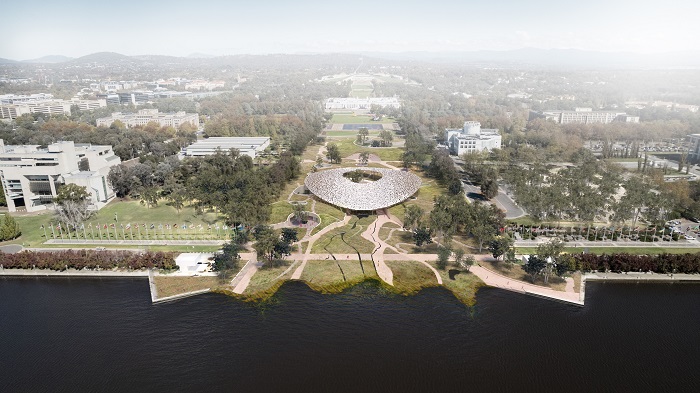An Indigenous-led concept envisioned by Djinjama and COLA Studio, Hassell and Edition Office has won the design competition for Ngurra: The National Aboriginal and Torres Strait Islander Cultural Precinct in Canberra.
This significant cultural landmark has been conceptualised in the form of two distinct spaces: the National Indigenous Knowledge and Cultural Centre, and the National Resting Place. The design for the Ngurra Cultural Precinct is specific to Country that is home to the Ngunnawal and Ngambri peoples, who have lived here for thousands of years. Appearing in different Aboriginal languages around the eastern parts of Australia, Ngurra is a word for ‘home’, ‘camp’, ‘a place of belonging’, or ‘a place of inclusion’.
About the winning design

Aerial view of the new cultural precinct Ngurra: The design for the national landmark houses both the National Indigenous Knowledge and Cultural Centre and the National Resting Place | Image by Hassell
Set within an undulating landscape, the design captures the drama, beauty and spontaneity of the beautiful wild grassland landscapes of Ngunnawal and Ngambri Country.
According to the jury, the winning design was “bold, yet elegant in integrating with the landscape” and commended “the commitment to rehabilitation of the site as a statement about the environment and First Nations connection to Country”.
The National Indigenous Knowledge and Cultural Centre incorporates a large, organic and embracing canopy, gently held aloft over a central plaza, marking the presence and arrival to the precinct, while providing shelter to all.
Held between the sky and the earth, the central plaza creates a new cultural and community room for Canberra, a place of welcome for ceremony, community events and functions.

Concept image of the Cultural Centre public space arrival area | Image by WAX
The National Resting Place is designed as a private ceremonial building, with the respectful eastern entry plaza making it a powerful symbolic reminder of historical truths, yet ensuring an introspective space for moments of reflection.
The building is composed of two structures – the curved embrace of the outer welcoming building, assembled under the gentle blanket of rolling grasslands, and the tall, standalone structure of the Resting Place sheltered within. The Repatriation Space lies in the centre of this form, in direct relationship to a secluded and sacred inner courtyard, allowing a highly protected place for ceremony.
“At the beginning of this project we asked that our Ancestors guide our hands and minds in the design and we believe they have done so. We know that Country has led our design team, and we believe this is the legacy of our project; Country, kin, and community embedded, guiding, fore-fronting First Nations culture,” says Dr Danièle Hromek, director of Djinjama, a First Nations cultural research and design agency.
Mark Loughnan, head of design and project director at Hassell says: “Djinjama guided us in an Indigenous-led design process that allowed us to sense Country, which means that deep time and memory have been captured into the design.”
“The result is a distinctive design concept, which creates a globally recognisable home for the National Indigenous Knowledge and Cultural Centre and the National Resting Place. It’s a design where Country, kin, and community are embedded. Landscape and built form merge together with equal value to provide living infrastructure for future generations to learn and reflect on their shared history,” he adds.
Edition Office directors, Kim Bridgland and Aaron Roberts, say: “It was an incredible honour to work with our team on this important and symbolic national project, together crafting a place where Indigenous Knowledge can be held and shared into the future, a place where Indigenous culture and identity can be seen, felt and witnessed at the heart of our capital city.”
Images: Supplied

